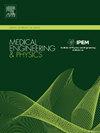Simulation study on parameter dependence of dynamic osteocyte response under low-magnitude high-frequency vibration
IF 1.7
4区 医学
Q3 ENGINEERING, BIOMEDICAL
引用次数: 0
Abstract
The dynamic response mechanism of osteocytes to whole-body low-amplitude high-frequency vibration (LMHFV) is investigated using numerical simulation. In this study, a finite element model of a single bone lacuna-osteocyte incorporating the cytoskeleton was established. The vibration parameter dependence characteristics (acceleration amplitude (a), frequency (f)) of the dynamic osteocyte response under LMHFV were simulated. The results demonstrate that the alternating positive and negative liquid pressure acted on the osteocyte under LMHFV protocols (0.01 g–0.05 g, 30 Hz) (g=gravitational acceleration, 1 g = 9.8 m/s2) and the fluid shear stress increase with the acceleration amplitude. Additionally, the absolute values of positive and negative liquid pressure are relatively higher in the parameters range (0.026 g–0.038 g, 30 Hz). The von Mises stress extreme value of the microtubules presents a non-linear variation with increasing vibration parameters. Moreover, cytoskeletons can generate higher stress under vibration protocols (0.02 g–0.03 g, 30–45 Hz), thus facilitating the transmission of mechanical signals while satisfying the mechanical strength conditions compared to other reasonable vibration parameter range (0.01 g–0.05 g, 30–45 Hz). In summary, LMHFV with appropriate parameters can improve the mechanical microenvironment of osteocytes and enhance cell bioactivity to some extent.
低频高频振动下骨细胞动态响应参数依赖性的模拟研究
采用数值模拟方法研究了骨细胞对全身低振幅高频振动的动态响应机制。在这项研究中,建立了一个包含细胞骨架的单个骨腔隙骨细胞的有限元模型。模拟了LMHFV作用下骨细胞动态响应的振动参数依赖特性(加速度振幅(a)、频率(f))。结果表明,在LMHFV方案下,正负压交替作用于骨细胞(0.01 g - 0.05 g, 30 Hz) (g=重力加速度,1 g= 9.8 m/s2),流体剪切应力随加速度幅值的增大而增大。在0.026 g - 0.038 g, 30 Hz范围内,正负压绝对值相对较大。微管的von Mises应力极值随振动参数的增加呈非线性变化。此外,与其他合理的振动参数范围(0.01 g - 0.05 g, 30-45 Hz)相比,细胞骨架在振动条件下(0.02 g - 0.03 g, 30-45 Hz)可以产生更高的应力,从而在满足机械强度条件的同时促进机械信号的传递。综上所述,适当参数的LMHFV可以在一定程度上改善骨细胞的力学微环境,增强细胞的生物活性。
本文章由计算机程序翻译,如有差异,请以英文原文为准。
求助全文
约1分钟内获得全文
求助全文
来源期刊

Medical Engineering & Physics
工程技术-工程:生物医学
CiteScore
4.30
自引率
4.50%
发文量
172
审稿时长
3.0 months
期刊介绍:
Medical Engineering & Physics provides a forum for the publication of the latest developments in biomedical engineering, and reflects the essential multidisciplinary nature of the subject. The journal publishes in-depth critical reviews, scientific papers and technical notes. Our focus encompasses the application of the basic principles of physics and engineering to the development of medical devices and technology, with the ultimate aim of producing improvements in the quality of health care.Topics covered include biomechanics, biomaterials, mechanobiology, rehabilitation engineering, biomedical signal processing and medical device development. Medical Engineering & Physics aims to keep both engineers and clinicians abreast of the latest applications of technology to health care.
 求助内容:
求助内容: 应助结果提醒方式:
应助结果提醒方式:


